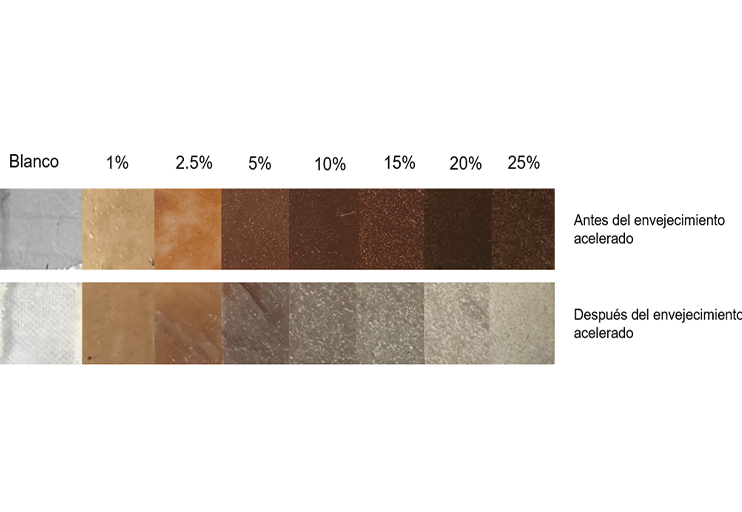Musa fiber-reinforced PLA biocomposites and their mechanical properties
DOI:
https://doi.org/10.29312/remexca.v16i30.4042Keywords:
composite material, Musa fiber, polylactic acidAbstract
This study analyzed polylactic acid biocomposites reinforced with banana (Musa) fiber, evaluating its effect on mechanical properties before and after accelerated aging. Analyses (FTIR, XRD, TGA) confirmed that the fiber contains hemicellulose, cellulose, and lignin, with a higher cellulose fraction due to its high crystallinity. Before aging, tensile strength and tensile modulus did not show a significant improvement with increasing fiber content, although impact strength and hardness did improve slightly. Nevertheless, elongation at break decreased. After 240 h of exposure in the UV chamber, the mechanical properties of the biocomposites degraded, with a reduction in tensile strength and modulus and an increase in elongation at break. Despite this, the reinforced biocomposites showed better mechanical properties than pure PLA after aging.
Downloads
References
Abbass, O. A.; Salih, A. I. and Al Hurmuzy, O. M. 2020. Study of the mechanical and physical properties of bio-composite material based on wheat starch and wheat straw fibers. IOP Conf. Ser.: Mater. Sci. Eng. 745:1-12. Doi: 10.1088/1757-899X/745/1/012075.
Adhikary, K. B.; Pang, S. and Staiger, M. P. 2008. Dimensional stability and mechanical behaviour of wood-plastic composites based on recycled and virgin high-density polyethylene (HDPE). Compos B Eng. 39(5):807-815. Doi: 10.1016/j.compositesb.2007.10.005.
Berzin, F.; Amornsakchai, T.; Lemaitre, A.; Castellani, R. and Vergnes, B. 2019. Influence of fiber content on rheological and mechanical properties of pineapple leaf fibers-polypropylene composites prepared by twin-screw extrusion. Polym. Compos. 40(12):4519-4529. Doi: 10.1002/pc.25308.
Christian, S. J. 2016. Natural fibre-reinforced noncementitious composites (biocomposites). In Nonconventional and Vernacular Construction Materials. Elsevier. 111-126. Doi: 10.1016/b978-0-08-100038-0.00005-6.
Cecci, R. R. R.; Passos, A. A. and Aguiar-Neto, T. C. 2020. Banana pseudostem fibers characterization and comparison with reported data on jute and sisal fibers. SN Appl. Sci. 2:20. Doi: 10.1007/s42452-019-1790-8.
Chun, K. S.; Husseinsyah, S. and Osman, H. 2012. Mechanical and thermal properties of coconut shell powder filled polylactic acid biocomposites: effects of the filler content and silane coupling agent. J. Polym. Res. 19(5):1-. Doi: 10.1007/s10965-012-9859-8.
Das, D.; Hussain, S.; Ghosh, A. K. and Pal, A. K. 2018. Studies on cellulose nanocrystals extracted from Musa sapientum: structural and bonding aspects. Cellul Chem Technol. 52(9-10):729-739.
Das, D.; Mukherjee, M.; Pal, A. K. y Ghosh, A. K. 2017. Extracción de fibras de xilema de Musa sapientum y caracterización. Fibers Polym. 18(11):2225-2234.
Díez, D.; Urueña, A.; Piñero, R.; Barrio, A. and Tamminen, T. 2020. Determination of hemicellulose, cellulose, and lignin content in different types of biomasses by thermogravimetric analysis and pseudocomponent kinetic model (TGA-PKM Method). Processes. 8(9):1-21. Doi: 10.3390/pr8091048.
Elshaarani, M. T.; Yaakob, Z.; Dahlan, K. Z. M. and Mohammad, M. 2013. Jatropha deoiled cake filler-reinforced medium-density polyethylene biocomposites: effect of filler loading and coupling agent on the mechanical, dynamic mechanical and morphological properties. Polym Compos. 34(5):746-756. Doi: 10.1002/pc.22479.
Gholampour, A. and Ozbakkaloglu, T. 2020. A review of natural fiber composites: properties, modification and processing techniques, characterization, applications. J. Mater Sci. 55(3):829-892. Doi: 10.1007/s10853-019-03990-y.
Islam, M. S.; Pickering, K. L. and Foreman, N. J. 2020. Influence of alkali treatment on the interfacial and physico mechanical properties of industrial hemp fibre reinforced polylactic acid composites. Polym. Degrad. Stabil. 95(1):59-65. Doi: 10.1016/j.compositesa.2010.01.006.
Kharchi, N.; Barka, B.; Rouabah, F.; Mourad, A. H. I.; Dadache, D.; Magali, F.; Houicha, H. and Bencid, A. 2025. Citric acid treatment: a new approach to improving Ampelodesma mauritanica fibers-poly-lactic acid composites. Ind. Crops Prod. 223-Art-120143. Doi: 10.1016/j.indcrop.2024.120143.
Khawas, P.; Das, A. J. and Deka, S. C. 2016. Production of renewable cellulose nanopaper from culinary banana (Musa ABB) peel and its characterization. Ind. Crops Prod. 86:102-112. Doi: 10.1016/j.indcrop.2016.03.028.
Nouri, M.; Griballah, I.; Tahlaiti, M.; Grondin, F. and Beaugrand, J. 2021. Plant extraction and physicochemical characterizations of untreated and pretreated diss fibers (Ampelodesmos mauritanicus). J. Nat. Fibers. 18(8):1083-1093. Doi: 10.1080/15440478.2019.1687062.
Oksman, K.; Skrifvars, M. and Selin, J. F. 2003. Natural fibres as reinforcement in polylactic acid (PLA) composites. Compos. Sci. Technol. 63(9):1317-1324. Doi: 10.1016/S0266-3538(03)00103-9.
Pereira, A. L. S.; Nascimento, D. M.; Filho, M. S.; Cassales, A. R.; Morais, J. P.; Paula, R. C. and Feitosa, J. P. 2014. Banana (Musa sp. cv. Pacovan) pseudostem fibers are composed of varying lignocellulosic composition throughout the diameter. BioResources. 9(4):7749-7763. Doi: 10.15376/BIORES.9.4.7749-7763.
Pant, M. and Palsule, S. 2025. Synergistic effects of Areca and pineapple fiber reinforcements for sustainability of functionalized polypropylene hybrid composites. Ind. Crops Prod. 223-Art-120253. Doi: 10.1016/j.indcrop.2024.120253.
Park, B. D. and Balatinecz, J. J. 1997. Mechanical properties of Wood fiber/toughened Isostatic polypropylene composites. Polymer Composites. 18(1):79-89.
Servais, C.; Luciani, A. and Månson, J. A. E. 2002. Squeeze flow of concentrated long fibre suspensions: experiments and model. Journal of Non-Newton Fluid Mechanics. 104(2-3):165-184. Doi: 10.1016/S0377-0257(02)00018-6.
Samilpa, A. R.; Ferreira, D. P. and Teixeira, M. A. 2022. Accelerated aging effect in physical and thermo-mechanical properties of maize starch biocomposites reinforced with Agave salmiana fibers from different leaf ages. Fibers Polym. 23(3):807-818. Doi: 10.1007/s12221-022-3151-2.
Werchefani, M.; Lacoste, C.; Belguith, H.; Gargouri, A. and Bradai, C. 2020. Effect of chemical and enzymatic treatments of alfa fibers on polylactic acid bio-composites properties. Journal of Composite Materials. 54(30):4959-4967. Doi: 10.1177/0021998320941579.
Wang, C. and Ying, S. 2014. A novel strategy for the preparation of bamboo fiber reinforced polypropylene composites. Fibers and Polymers. 15(1):117-125. Doi: 10.1007/s12221-014-0117-z.
Xu, C.; Zhu, S.; Xing, C.; Li, D.; Zhu, N. and Zhou, H. 2015. Isolation and properties of cellulose nanofibrils from coconut palm petioles by different mechanical processes. PLoS One. 10(4):1-11. Doi: 10.1371/journal.pone.0122123.
Yaisun, S. and Trongsatitkul, T. 2023. PLA based hybrid biocomposites: effects of fiber type, fiber content, and annealing on thermal and mechanical properties. Polymers. 15(20)-Art-4106. Doi: 10.3390/polym15204106.
Yousefi, H.; Faezipour, M.; Hedjazi, S.; Mousavi, M. M.; Azusa, Y. and Heidari, A. H. 2013. Comparative study of paper and nanopaper properties prepared from bacterial cellulose nanofibers and fibers/ground cellulose nanofibers of canola straw. Ind. Crops Prod. 43(2):732-737. Doi: 10.1016/j.indcrop.2012.08.030.
Yusoff, R. B.; Takagi, H. and Nakagaito, A. N. 2023. A comparative study of polylactic acid (PLA)-based unidirectional green hybrid composites reinforced with natural fibers such as kenaf, bamboo and coir. Hybrid Advances. 3(1). Doi: 10.1016/j.hybadv.2023.100073.
Zwawi, M. A. 2021. Review on natural fiber bio composites, surface modifications and applications. Molecules. 26(2)-Art-404. Doi: 10.3390/molecules26020404.

Published
How to Cite
Issue
Section
License
Copyright (c) 2025 Revista Mexicana de Ciencias Agrícolas

This work is licensed under a Creative Commons Attribution-NonCommercial 4.0 International License.
The authors who publish in Revista Mexicana de Ciencias Agrícolas accept the following conditions:
In accordance with copyright laws, Revista Mexicana de Ciencias Agrícolas recognizes and respects the authors’ moral right and ownership of property rights which will be transferred to the journal for dissemination in open access. Invariably, all the authors have to sign a letter of transfer of property rights and of originality of the article to Instituto Nacional de Investigaciones Forestales, Agrícolas y Pecuarias (INIFAP) [National Institute of Forestry, Agricultural and Livestock Research]. The author(s) must pay a fee for the reception of articles before proceeding to editorial review.
All the texts published by Revista Mexicana de Ciencias Agrícolas —with no exception— are distributed under a Creative Commons License Attribution-NonCommercial 4.0 International (CC BY-NC 4.0), which allows third parties to use the publication as long as the work’s authorship and its first publication in this journal are mentioned.
The author(s) can enter into independent and additional contractual agreements for the nonexclusive distribution of the version of the article published in Revista Mexicana de Ciencias Agrícolas (for example include it into an institutional repository or publish it in a book) as long as it is clearly and explicitly indicated that the work was published for the first time in Revista Mexicana de Ciencias Agrícolas.
For all the above, the authors shall send the Letter-transfer of Property Rights for the first publication duly filled in and signed by the author(s). This form must be sent as a PDF file to: revista_atm@yahoo.com.mx; cienciasagricola@inifap.gob.mx; remexca2017@gmail.
This work is licensed under a Creative Commons Attribution-Noncommercial 4.0 International license.


